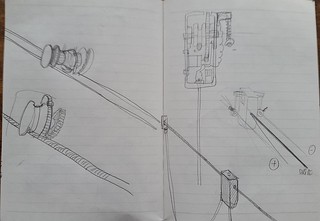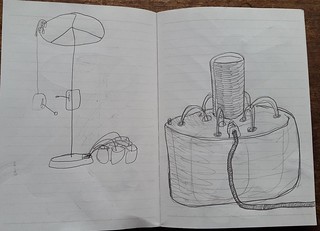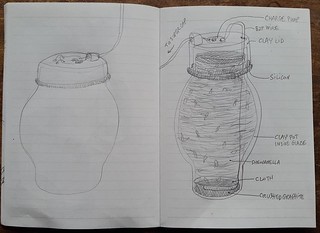Table of Contents
Power of the Mud - Intersession #1
This page relates the parallel advances of the Power of the Mud project made respectively by Paul Granjon in Cardiff and Michka Melo in Brussels between their intensive work session which took place in Cardiff in September 2016 and May 2017.
Abstract
- Regarding the Mudwatts we set up during our last session, the first to start (during the session itself) maintained a high performance behavior, blinling around 3-4 times per second over the course of several months. It just slowed down a little during Christams holidays, because it dried up, but once watered, it was back on track.
- The other two never started. Paul consequently washed them and filled them back with the good estuary slush we provided to the first one, and they started, later and slower than our first champion. The first one blinked approximately once every 1.5 sec, the other once every 4 sec.
- Regarding joule thief (JT) circuit tests, we managed to light up and LED with a voltage as low as 0.46 V and a current as low as 0.8 mA.
- As a comparison, we saw that the lowest voltage at which the LED would light up without the JT circuit would be 1.654 V. In these conditions, it would consume much less current (0.05 mA).
- During this intersession, we also exchanged first conceptual ideas regarding our upcoming robotic installation at V&A.
Paul, September 14th - Mudwatt news
- Two Mudwatts are still not working, but the one with the Barry estuary slush blinks 3-4 times per second.
Brussels, September 23rd - Joule thief circuit experiments

Setup
- Power source
- Lab power supply with automatic current regulation
- 100 kohms adjustable resistor between the + pin of the power supply and the + pin of the currentmeter.
- Measurements
- Analog currentmeter going from 0 to 1 mA, placed in series between the adjustable resistor and the joule thief circuit.
- Digital voltmeter measuring the voltage between the - pole of the adjustable potentiometer and the ground.
- Joule thief (JT) circuit
- 2N3904 transistor
- Coil, made of
- A 2.5 cm ferrite tore
- 10 coils of wire
- A measured resistance around 0.7 ohm
- This measure may be imprecise, as a commercial 1 ohm resistor was measured at 1.6 ohm by the same digital ohmmeter
- A yellow LED
- A 1 ohm resistor in series between the + pin of the power supply and the feedback coil
- Connection pattern similar to this one
Results
- LED on JT
- Little light spot on yellow LED at 0.46 V and 0.8 mA, which disappears at 0.6 mA.
- We cannot see any visible difference when placing a 47 uF across the + and - of the power source.
- LED alone (fed by the power supply without the JT circuit)
- Little light spot at 1.654 V and 0.05 mA.
- Quite bright at 1.8 V and 0.3 mA.
- Very bright at 1.9 V and 0.4 mA.
- Therefore, current does not seem to be the limiting factor to feed the JT.
Does it work to use a joule thief circuit to charge a capacitor ?
- According to this source, it seems to work to put a capacitor as an output, as long as there is a diode (potentially an LED) to keep the voltage low.
- Very well explained in the article itself.
Michka, February 28th - Robot concept ideas for V&A



Paul, March 6th - Robot concept ideas for V&A








Michka, end of April - Replicating the JT experiments
- The replication of the experiments performed during the intersession in September failed.
- As a consequence, we put aside this hypothesis for the moment.
Paul, May 4th - Mudwatt news
- The two non-working Mudwatt were washed and their mud source was replaced by the good slush which made the other Mudwatt work so well.
- After the usual setup time (few days), they started up slowly, one blinking every 1.5 s, and the other every 4s.
